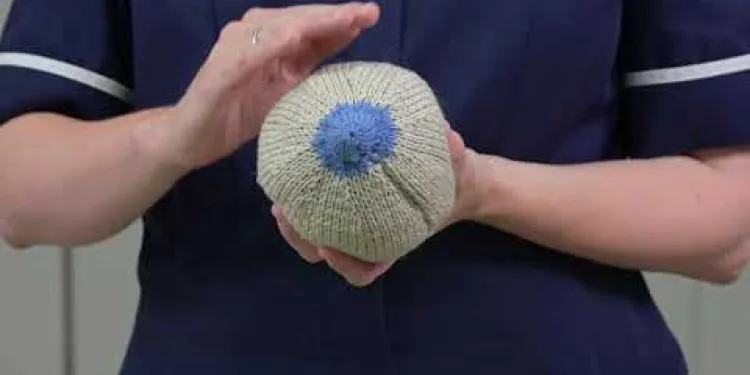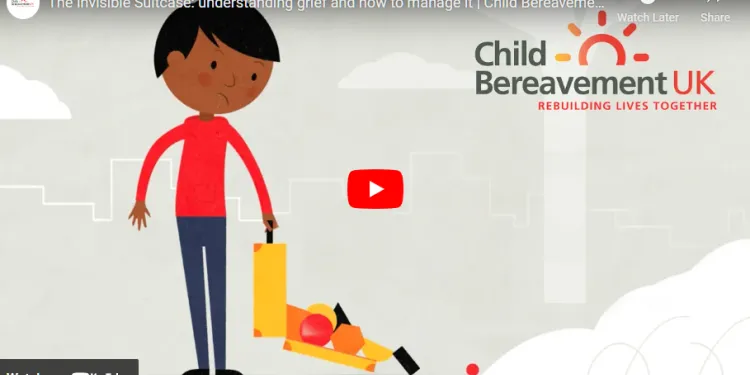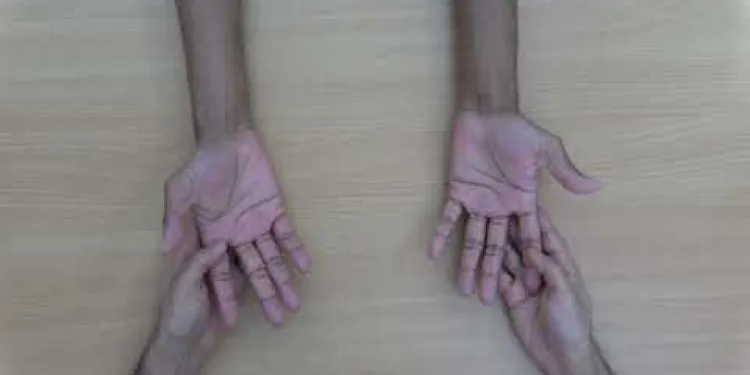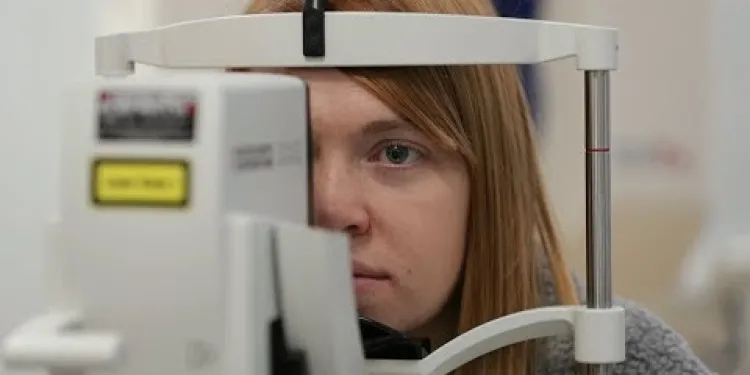Find Help
More Items From Ergsy search
-

Hand expressing
Relevance: 100%
-

Post hand surgery - Stiffness management and trigger finger
Relevance: 35%
-

What are the common symptoms of Carpal Tunnel Syndrome?
Relevance: 14%
-

How do I talk to my partner about how I’m feeling?
Relevance: 13%
-

How can I prevent spreading my cold to others?
Relevance: 12%
-

Child Bereavement
Relevance: 12%
-

What is the recovery time after Carpal Tunnel Surgery?
Relevance: 12%
-

How can I prevent norovirus infection?
Relevance: 12%
-

How can I prevent Carpal Tunnel Syndrome?
Relevance: 11%
-

What is Carpal Tunnel Syndrome (CTS)?
Relevance: 11%
-

Can lifestyle changes help manage Carpal Tunnel Syndrome?
Relevance: 11%
-

What non-surgical treatments are available for Carpal Tunnel Syndrome?
Relevance: 11%
-

How is norovirus spread?
Relevance: 10%
-

What does Carpal Tunnel Syndrome surgery involve?
Relevance: 10%
-

How do people get infected with E. coli?
Relevance: 10%
-

What are the primary symptoms of motor neurone disease?
Relevance: 10%
-

Controversy Surrounds New Surveillance Legislation as Privacy Groups Voice Concerns
Relevance: 10%
-

How can I protect myself from new COVID-19 variants?
Relevance: 10%
-

What are some preventive measures against H3N2?
Relevance: 10%
-

The Human Rights Act
Relevance: 9%
-

How can I protect myself from Covid-19 variants?
Relevance: 9%
-

How to remove your hearing aid
Relevance: 9%
-

Stage One Paperwork | UK Adoption Journey
Relevance: 9%
-

Government Faces Legal Challenge Over Proposed Immigration Bill
Relevance: 9%
-

How can healthcare workers protect themselves from Marburg virus infection?
Relevance: 9%
-

What are the signs of autism?
Relevance: 9%
-

What precautions can be taken to avoid Super Flu?
Relevance: 9%
-

Talking about self-harm | NHS
Relevance: 9%
-

What feedback do customers give regarding banking fees?
Relevance: 9%
-

What are the signs of honour based abuse?
Relevance: 9%
-

Can I go to work or school if I have norovirus?
Relevance: 9%
-

Dupuytrens
Relevance: 9%
-

How can I prevent the spread of impetigo?
Relevance: 9%
-

Can I work or continue sports activities if I have Carpal Tunnel Syndrome?
Relevance: 9%
-

Patient voices in type one diabetes - I would have done things differently.
Relevance: 8%
-

What should I do if my partner dismisses my feelings of depression?
Relevance: 8%
-

Carpal Tunnel Syndrome
Relevance: 8%
-

Can Carpal Tunnel Syndrome recur after treatment?
Relevance: 8%
-

Advice if your child has... A High temperature
Relevance: 8%
-

Are there specific exercises that can help with Carpal Tunnel Syndrome?
Relevance: 8%
Hand expressing milk is a valuable skill for breastfeeding mothers, offering several benefits for both mother and baby. This technique involves using your hands to manually extract breast milk from your breast. Here's a brief overview of hand expressing milk:
- Preparation: Before starting, ensure your hands and breasts are clean. Find a comfortable, quiet place to relax, which can stimulate the milk ejection reflex.
- Hand Positioning: Begin by washing your hands thoroughly. Sit or stand in a comfortable position. Gently massage your breast with a circular motion to stimulate milk flow. Cup your breast with one hand, fingers underneath, and thumb on top, a few centimeters behind the areola.
- Expressing Milk: Apply gentle pressure using your thumb and fingers to compress the milk ducts. Press inward toward your chest wall, then release, repeating this motion rhythmically. Avoid pressing on the areola itself, as it may hinder milk flow.
- Collecting Milk: Use a clean container, such as a sterilized glass or plastic bottle, to catch the expressed milk. Ensure it is properly sanitized to maintain milk quality.
- Switch Sides: After expressing from one breast, switch to the other, alternating until you feel satisfied or until both breasts are comfortably emptied.
- Storage: Store the expressed milk in a clean, labeled container in the refrigerator or freezer for future use. Follow guidelines for safe milk storage and ensure proper hygiene throughout the process.
Hand expressing milk can be particularly useful for relieving breast engorgement, helping premature or ill babies receive colostrum, or as a supplement to breastfeeding or pumping. It also provides a valuable tool for assessing milk supply and addressing latch issues. While it may take some practice to master, hand expressing is a valuable skill that can enhance the breastfeeding experience for both mother and baby.
Hand Expressing: A Guide for UK Mothers
What is Hand Expressing?
Hand expressing is a technique used to manually extract breast milk. It can be a convenient and effective method for breastfeeding mothers to collect milk when a breast pump is unavailable, or to relieve engorgement and ensure that the baby has an adequate milk supply.
Why Choose Hand Expressing?
Hand expressing is beneficial for several reasons. It requires no equipment, making it cost-effective and accessible. Mothers can also find it gentler on their breasts compared to using a pump. In emergencies or when feeding schedules are disrupted, hand expressing ensures that milk is available for the infant and helps maintain milk production.
When to Hand Express?
Mothers might choose to hand express in various situations. These include situations where the baby has difficulty latching, during periods when the mother is away from the baby, or to relieve engorgement. It is common for UK mothers to hand express to feed preterm babies or donate milk to milk banks.
How to Hand Express: Step-by-Step
Here is a basic guide on how to hand express breast milk:
- Wash your hands thoroughly before starting.
- Get into a comfortable seated position and have a clean container ready to collect the milk.
- Gently massage your breasts in a circular motion to stimulate milk flow.
- Place your thumb and fingers around the areola and press back towards your chest.
- Compress your thumb and fingers together gently and rhythmically to express milk.
- Rotate your thumb and fingers around the breast to express from different areas.
- Continue until the milk flow slows down.
- Repeat the same process on the other breast.
Storing Expressed Milk
Proper storage of expressed milk is essential for maintaining its quality and safety. In the UK, it is recommended to use sterilised containers to store expressed milk. Freshly expressed milk can be stored at room temperature (up to 25°C) for up to 6 hours, in the refrigerator (at 4°C or lower) for up to 5 days, and in the freezer (-18°C or lower) for up to 6 months.
Conclusion
Hand expressing is a valuable skill for breastfeeding mothers in the UK. It is an effective way to manage milk supply and ensures that mothers can provide for their babies even in situations where breastfeeding directly is not possible. By understanding and practicing hand expressing, mothers can enjoy greater flexibility and peace of mind.
Hand expressing milk means using your hands to get milk from your breast. This can be really helpful for moms who are breastfeeding. Here’s how you can do it:
- Getting Ready: First, make sure your hands and breasts are clean. Find a peaceful spot to sit and relax. This helps your milk to flow.
- Hand Placement: Wash your hands well. Sit or stand in a comfy position. Gently rub your breast in circles to help the milk start flowing. Hold your breast with one hand. Put your fingers under your breast and your thumb on top, but not too close to the nipple.
- Expressing Milk: Gently press down with your thumb and fingers to squeeze the milk out. Press toward your chest, then let go. Repeat this over and over. Try not to press right on the nipple, as this can stop the milk from coming out.
- Collecting Milk: Catch the milk in a clean container like a sterilized bottle. Make sure everything is clean to keep the milk safe.
- Change Sides: After getting milk from one breast, switch to the other. Keep changing sides until you feel done or both breasts feel softer.
- Storing Milk: Put the milk in a clean container with a label. Store it in the fridge or freezer to use later. Follow the rules for storing milk safely and keep everything clean.
Hand expressing milk is good for a few reasons. It can help if your breasts feel too full. It can also help babies who need extra help feeding, like those who are born early. Plus, it’s a way to make sure your baby is getting enough milk if you're having trouble breastfeeding. It might take a little practice, but it’s a useful skill for moms and their babies.
Hand Expressing: A Guide for UK Mothers
What is Hand Expressing?
Hand expressing means using your hands to get milk from your breasts. It can be useful if you do not have a breast pump. It helps when your breasts feel too full or the baby needs more milk.
Why Choose Hand Expressing?
Hand expressing has many good points. You do not need to buy anything, so it is cheap. Some mothers find it more gentle than a pump. It helps make sure your baby has milk anytime, even if you are not there.
When to Hand Express?
You may decide to hand express when: your baby cannot latch onto the breast, you are away from your baby, or your breasts are too full. You can also do it to help small babies in hospitals or to give milk to milk banks.
How to Hand Express: Step-by-Step
Follow these steps to hand express:
- Wash your hands well.
- Sit comfortably and have a clean container to catch the milk.
- Rub your breasts gently in circles to help the milk come out.
- Put your thumb and fingers around the dark part of your breast.
- Press gently towards your chest and then squeeze your fingers together to get the milk.
- Move your fingers around to express milk from different areas.
- Keep going until the milk slows down.
- Do the same with the other breast.
Storing Expressed Milk
You need to store milk safely. In the UK, use clean containers for the milk. Fresh milk can sit at room temperature (up to 25°C) for 6 hours, in the fridge (4°C or lower) for 5 days, and in the freezer (-18°C or lower) for 6 months.
Conclusion
Hand expressing is a useful skill for mothers. It helps make sure babies get milk even if direct breastfeeding is hard. By learning how to hand express, you can have more options and feel more relaxed.
Frequently Asked Questions
What is hand expressing?
Hand expressing is the technique of using your hands to massage and compress your breast to remove milk. This can be especially useful in the early days after birth or if you are away from your baby.
When should I start hand expressing?
You can start hand expressing as soon as your baby is born, especially if you are unable to breastfeed directly. Midwives often recommend starting within the first few hours to help initiate milk supply.
How do I prepare for hand expressing?
Wash your hands thoroughly with soap and water. Make sure you have a clean container to collect the milk. Relax and find a comfortable, quiet place to express.
What is the most effective way to hand express?
Start by massaging your breast in circular motions to stimulate milk flow. Then, place your thumb and fingers around your nipple and gently compress and release in a rhythmic motion.
How often should I hand express?
It depends on your needs. If you're building up a supply, you might hand express every 3-4 hours. If it's to relieve engorgement or collect occasional milk, you can do it as needed.
How long should each hand expressing session last?
Each session can last around 20-30 minutes. However, the duration may vary based on how much milk you are able to express and your comfort level.
What are the benefits of hand expressing?
Hand expressing can help maintain or increase milk supply, relieve engorged breasts, and provide milk for your baby if breastfeeding is not possible at the moment.
Can I store the expressed milk?
Yes, you can store expressed milk in sterilised containers. It can be stored in the fridge for up to 5 days at 4°C or lower, or in the freezer for up to 6 months.
What should I do if hand expressing is painful?
If you experience pain while hand expressing, it may be due to incorrect technique. Try adjusting your hand placement or the pressure you're using. If pain persists, consult a lactation consultant or your healthcare provider.
Can hand expressing help with engorgement?
Yes, hand expressing can help relieve the discomfort of engorged breasts by removing some of the milk and easing the pressure.
Is hand expressing an effective way to increase milk supply?
Hand expressing can stimulate milk production, especially when done frequently. It's often recommended in conjunction with other breastfeeding techniques to increase supply.
Can I hand express if my baby is premature?
Yes, hand expressing is actually encouraged for mothers of premature babies as it helps establish and maintain milk supply. The colostrum and breast milk are beneficial for the baby's health.
Are there any risks associated with hand expressing?
When done correctly, hand expressing is safe and effective. However, improper technique can cause nipple soreness or damage. It’s important to follow proper instructions and seek guidance if you’re unsure.
Can I combine hand expressed milk with pumped milk?
Yes, you can combine hand expressed milk with pumped milk as long as both batches are cooled to the same temperature before mixing.
What should I do if I'm not able to express any milk?
If you're having difficulty expressing milk, make sure you are relaxed and properly hydrated. You can try warm compresses or gentle breast massage before expressing. If problems persist, seek help from a lactation consultant or healthcare provider.
What is hand expressing?
Hand expressing is when you use your hands to get milk out of your breast. You do this by gently squeezing your breast with your fingers. It can help if your baby can't breastfeed right away or you want to save milk for later.
Here are some tips to help:
- Wash your hands before you start.
- Find a quiet and comfortable place.
- Massage your breast gently to get the milk flowing.
Ask a friend or nurse to show you how, if you need help.
Hand expressing means using your hands to squeeze and massage your breast to get milk out. This is helpful right after your baby is born or if you are not with your baby.
When do I start hand expressing?
You can begin hand expressing your milk when your baby is born. This is helpful if you can't breastfeed right away. Nurses say it's good to start within the first few hours to help your milk come in.
Getting Ready to Hand Express
Wash your hands well with soap and water. Use something clean to catch the milk. Sit somewhere comfy and quiet to help you relax.
How can I hand express milk the best way?
Here is how you can do it:
- Wash your hands first.
- Massage your breast gently.
- Make a C shape with your hand around your breast.
- Press and release gently.
- Collect the milk in a clean container.
Some tools might help:
- Use a warm cloth on your breast to relax.
- Listen to calming music or watch a relaxing video.
First, gently rub your breast in circles. This helps the milk start moving. Then, put your thumb and fingers around your nipple. Squeeze and let go softly, like a little rhythm.
How often should I squeeze milk from my breast?
Milk squeezing is a way to get milk out of your breast using your hands. It helps if you have lots of milk or need to save some for later.
Here's when you can do it:
- When your breasts feel full.
- If your baby can't breastfeed right away.
- To keep your milk supply up.
Ask a nurse or doctor if you need help. Using a warm cloth on your breast or doing it after a warm shower can help. A pump can also be useful if you have one.
How often you need to hand express depends on what you need.
If you want to save up milk, you can hand express every 3 to 4 hours.
If you only want to feel better or get some milk sometimes, you can hand express when you need to.
How long should you do hand expressing?
When you squeeze milk from your breast with your hand, it is called hand expressing. This can take about 20 to 30 minutes each time.
Here are some tips to help you:
- Find a quiet and comfy place to sit.
- Use a warm cloth on your breast to help the milk come out.
- Take deep breaths and stay relaxed.
Each session can last about 20 to 30 minutes. But the time might be different depending on how much milk you can get and how comfortable you feel.
Why is hand expressing good?
Hand expressing means using your hands to get milk out of your breasts. This can help keep your milk flowing well. It can also help if your breasts feel too full. If you can’t breastfeed right now, hand expressing can get milk for your baby.
Can I keep the milk I pumped?
Yes, you can keep breast milk in clean bottles. You can keep it in the fridge for 5 days if the fridge is very cold, at 4°C or less. You can also keep it in the freezer for up to 6 months.
What can I do if hand expressing hurts?
If squeezing milk from your breast with your hand makes you hurt, you can try these things:
- Be gentle: Press softly so it does not hurt.
- Warm cloth: Put a warm cloth on your breast before you start.
- Relax: Take deep breaths to calm down.
- Use cream: If your skin is sore, ask a doctor about using a cream.
- Get help: Talk to a nurse or doctor if it still hurts.
These tips can make it easier and feel better.
If you feel pain when you are pressing milk out of your breast, you might not be doing it the right way. Try changing where your hand is or how hard you press. If it still hurts, ask a milk helper or your doctor for help.
Can squeezing milk out by hand help with very full breasts?
When your breasts feel very full, it can hurt. Squeezing milk out by hand can help. It can make your breasts feel better. This is called "hand expressing."
Here are some tips to help you:
- Sit in a comfy place and relax.
- Have a warm cloth to put on your breast. This can make it easier.
- Use gentle hands to massage your breast.
- Cup your breast with one hand. Use your other hand's fingers to press and squeeze gently.
If you need more help, ask a nurse or midwife. They can show you what to do.
Yes, you can use your hands to squeeze out some milk. This helps if your breasts are full and hurt. It makes them feel better.
Can squeezing milk by hand help make more milk?
Squeezing milk out of your breasts by hand can help you make more milk. It's good to do this a lot. Try doing this along with other ways of breastfeeding to get more milk.
Can I squeeze out my milk if my baby is born early?
Yes, mothers with early-born babies are encouraged to use their hands to get milk. This helps make sure they have enough milk. The first milk, called colostrum, and breast milk are very good for the baby's health.
Here are some ways to help:
- Use a warm cloth on your breast to help start the milk.
- Gently massage your breast before you start.
- Ask a nurse or doctor to show you how to do it.
- Practice can make it easier over time.
- Look for videos online that can show you how.
Is hand expressing safe?
Hand expressing is a way to get milk out of your breast using your hands. It is safe when done the right way. But if you don't do it right, it might hurt your nipples or make them sore. Always use the right steps. If you are not sure how to do it, ask someone for help.
Can I mix milk I squeeze by hand with milk I use a pump for?
Yes, you can mix milk you squeeze by hand with milk you use a pump to get. But make sure both kinds of milk are cooled to the same temperature first.
What can I do if I can't get milk out?
If you find it hard to get milk out, try to stay calm and drink plenty of water. You can use a warm cloth or gently rub your breast before you try. If you still have trouble, talk to someone who helps with breastfeeding or see a doctor.
Useful Links
- Ergsy carfully checks the information in the videos we provide here.
- Videos shown by Youtube after a video has completed, have NOT been reviewed by ERGSY.
- To view, click the arrow in centre of video.
- Most of the videos you find here will have subtitles and/or closed captions available.
- You may need to turn these on, and choose your preferred language.
- Go to the video you'd like to watch.
- If closed captions (CC) are available, settings will be visible on the bottom right of the video player.
- To turn on Captions, click settings .
- To turn off Captions, click settings again.
More Items From Ergsy search
-

Hand expressing
Relevance: 100%
-

Post hand surgery - Stiffness management and trigger finger
Relevance: 35%
-

What are the common symptoms of Carpal Tunnel Syndrome?
Relevance: 14%
-

How do I talk to my partner about how I’m feeling?
Relevance: 13%
-

How can I prevent spreading my cold to others?
Relevance: 12%
-

Child Bereavement
Relevance: 12%
-

What is the recovery time after Carpal Tunnel Surgery?
Relevance: 12%
-

How can I prevent norovirus infection?
Relevance: 12%
-

How can I prevent Carpal Tunnel Syndrome?
Relevance: 11%
-

What is Carpal Tunnel Syndrome (CTS)?
Relevance: 11%
-

Can lifestyle changes help manage Carpal Tunnel Syndrome?
Relevance: 11%
-

What non-surgical treatments are available for Carpal Tunnel Syndrome?
Relevance: 11%
-

How is norovirus spread?
Relevance: 10%
-

What does Carpal Tunnel Syndrome surgery involve?
Relevance: 10%
-

How do people get infected with E. coli?
Relevance: 10%
-

What are the primary symptoms of motor neurone disease?
Relevance: 10%
-

Controversy Surrounds New Surveillance Legislation as Privacy Groups Voice Concerns
Relevance: 10%
-

How can I protect myself from new COVID-19 variants?
Relevance: 10%
-

What are some preventive measures against H3N2?
Relevance: 10%
-

The Human Rights Act
Relevance: 9%
-

How can I protect myself from Covid-19 variants?
Relevance: 9%
-

How to remove your hearing aid
Relevance: 9%
-

Stage One Paperwork | UK Adoption Journey
Relevance: 9%
-

Government Faces Legal Challenge Over Proposed Immigration Bill
Relevance: 9%
-

How can healthcare workers protect themselves from Marburg virus infection?
Relevance: 9%
-

What are the signs of autism?
Relevance: 9%
-

What precautions can be taken to avoid Super Flu?
Relevance: 9%
-

Talking about self-harm | NHS
Relevance: 9%
-

What feedback do customers give regarding banking fees?
Relevance: 9%
-

What are the signs of honour based abuse?
Relevance: 9%
-

Can I go to work or school if I have norovirus?
Relevance: 9%
-

Dupuytrens
Relevance: 9%
-

How can I prevent the spread of impetigo?
Relevance: 9%
-

Can I work or continue sports activities if I have Carpal Tunnel Syndrome?
Relevance: 9%
-

Patient voices in type one diabetes - I would have done things differently.
Relevance: 8%
-

What should I do if my partner dismisses my feelings of depression?
Relevance: 8%
-

Carpal Tunnel Syndrome
Relevance: 8%
-

Can Carpal Tunnel Syndrome recur after treatment?
Relevance: 8%
-

Advice if your child has... A High temperature
Relevance: 8%
-

Are there specific exercises that can help with Carpal Tunnel Syndrome?
Relevance: 8%


